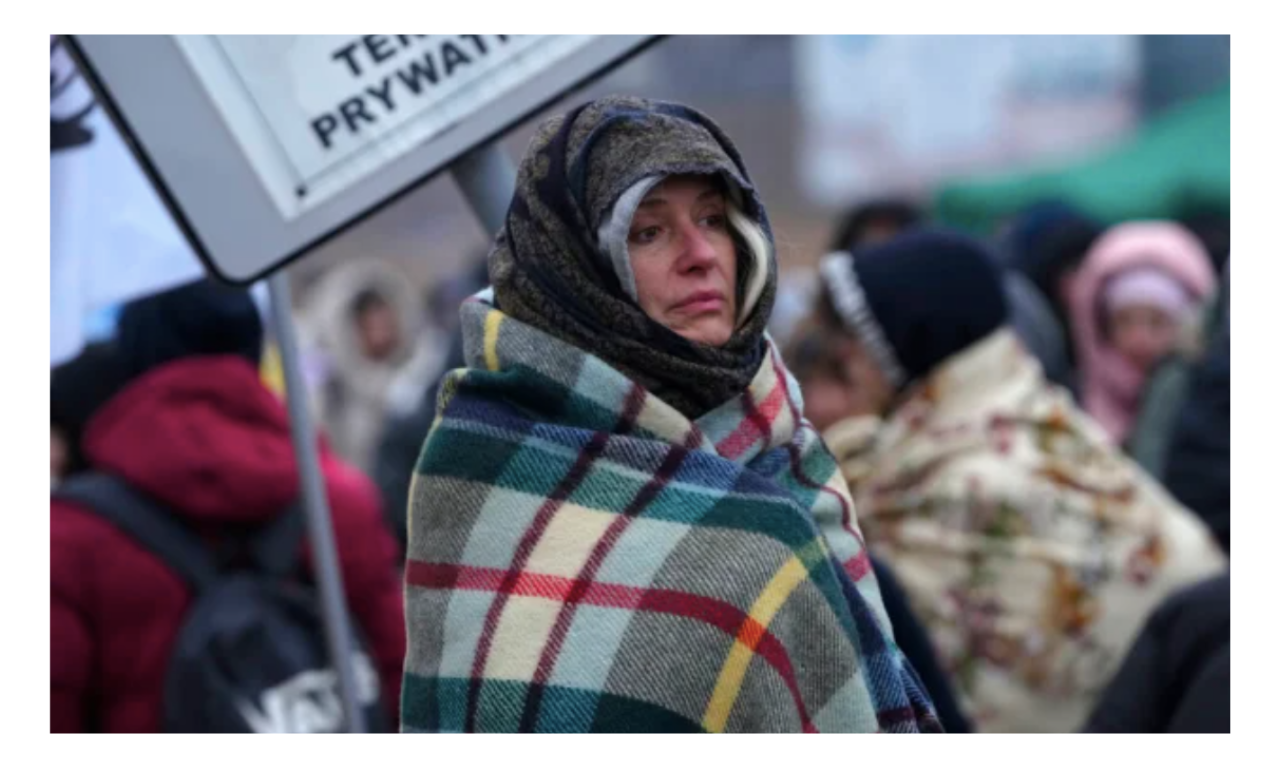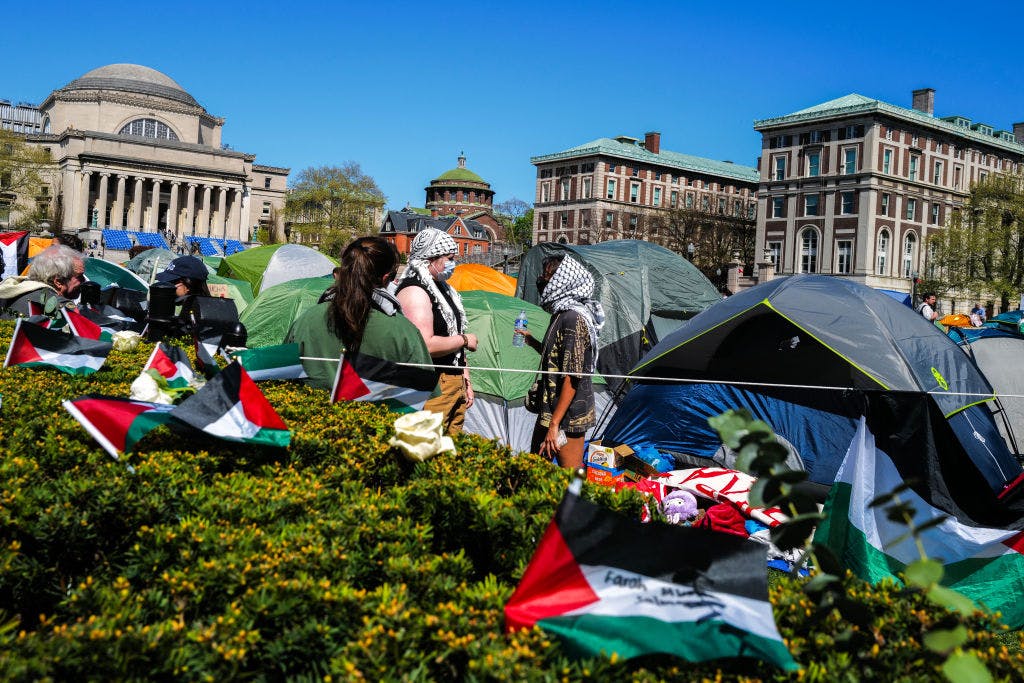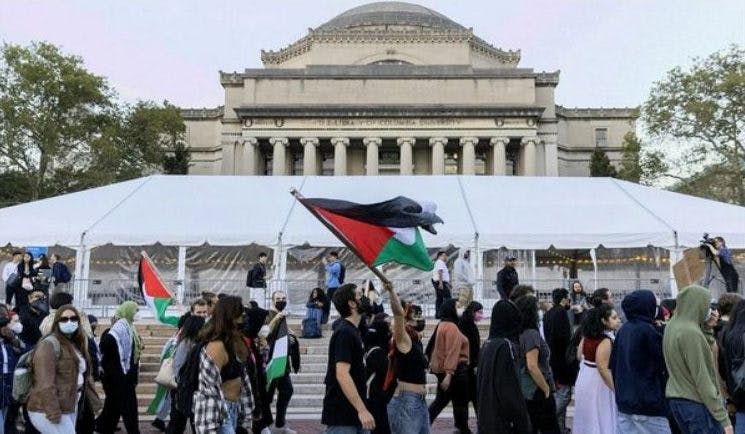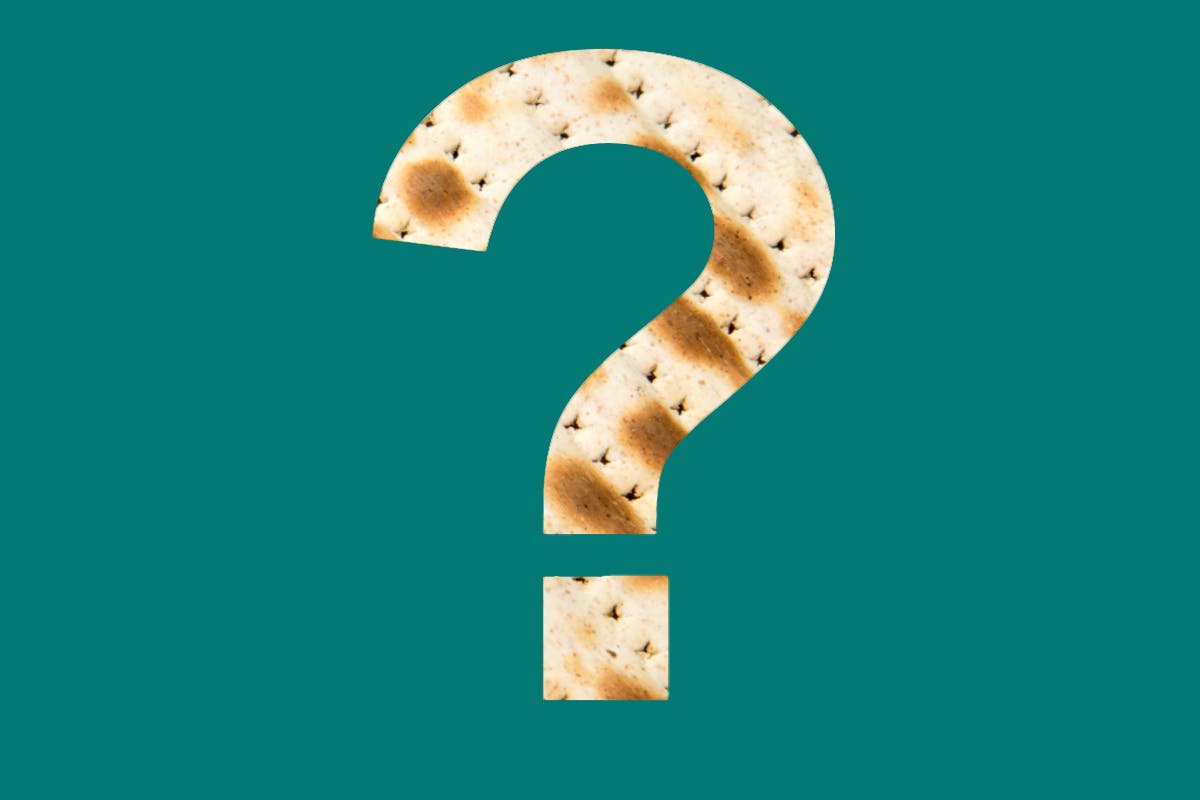Published: 2 November 2022
Last updated: 5 March 2024
On his recent visit to Poland and Germany, ARNOLD ZABLE finds the victims of a new war intermingling with the ghosts of an old one. His journey begins in Krakow.
June 28, 2022. Melbourne airport. My first overseas flight since the start of the pandemic. I am back in touch with a random humanity. The first leg to Bangkok, the second, to Munich, the final, a one-hour flight to Krakow.
A veil of haze on a summer morning as we take off from Munich airport. Below, glimpses of Bavaria: tiled farmhouses, and fallow fields alternating with ripe-green paddocks. The landscape vanishes beneath the clouds. Nature throws up haikus: A strip of blue, cutting through billowing white: river of the skies. A stretch of cumulus, kilometres long: an elongated ribbon.
We cannot land, there’s a thunderstorm over Krakow airport. We circle above the clouds. There is no sound, no turbulence. Beyond the horizon, not far distant, towns are being laid to waste, cities bombarded. I start up a conversation with the passenger seated beside me: Dale Umetsu, a retired paediatrician, who lives in San Francisco. He has volunteered to work in Ukraine with displaced children cut off from medical treatment. We agree to stay in touch. He will send me dispatches from the frontline.
The storm is over. As soon as the plane taxis to a halt, the doctor grabs his overnight bag. He is travelling light. No need to wait at the baggage carousel. He is running late; he has a train to catch to the borderlands.
MY PARENTS WERE from the borderlands: my father, Meier, from the city of Bialystok, and my mother, Hadassah, from the nearby shtetl of Grodek. Born in 1905, Meier liked to say that by the time he was 12 he had lived in three countries, Russia, Germany, Poland, and gone nowhere.
THE DRIVE FROM KRAKOW airport; it drizzles, the aftermath of the storm. The ageing apartment blocks on the city outskirts are intact, though somewhat jaded: facades cracked, the stucco peeling. Nearing the centre, the streets widen into spacious squares and boulevards. I disembark in Kazimierz, the former Jewish quarters: Welcome home, the cobblestones sing.
It is mid-2022, but it is the 1930s that come to mind. Krakow is familiar, not only because I’ve been here several times before, but because my pre-conceptions of Polish cities are deeply imbedded in my imagination — first pictured in family albums and the illustrated Yiddish magazines and journals my father brought with him in 1936 from Poland to New Zealand.
I carry within me distinct images of how people of my parents’ generation, from Hasidim to modernists, were dressed as they moved about. The thoroughfares of Krakow are a set for a pre-war film. All that’s needed is for the extras to fill the streets, and the cameras to start rolling. Back then, few could have foreseen the impending horror.
A DAWN WALK in the streets of Kazimierz. Commuters are on their way to work by tram. A woman vacuums the stone foyer of her apartment block. A shopkeeper is unlocking his store; he steps back on the deserted street for a smoke. Then I see them, a gathering of perhaps one hundred women and children.
A truck is pulled up, offloading supplies; the Jewish Community centre has been given over to the mass effort to assist displaced Ukrainians.
On the women’s faces, that look which says: “How is this possible? Just weeks, months ago I had a life, a home, my tiny patch on this Earth. Now I’m adrift, dependent on the generosity of others.” The initial shock of dislocation has been replaced by an expression of weary resignation. The women stand on the pavement outside the gates of the Jewish Community Centre. A truck is pulled up, offloading supplies; the centre has been given over to the mass effort to assist displaced Ukrainians.
In this moment is contained a scene re-enacted for millennia. I cannot tear myself from it. I am riveted, and duty bound to record it: the body language, the slight slouch, the pursed lips, the nervous draw on a cigarette. But there is something else, an edge of defiance, the stoic gaze that says: “I will not be defeated. I have children to take care of, elderly parents to look after, menfolk on the frontline. I have my dignity, my right to belong.” Meanwhile, they wait. Wait for the doors to open. Wait for supplies that will see them through the coming days. Wait for an end to their waiting.
In this moment is contained a scene re-enacted for millennia. I cannot tear myself from it. I am riveted, and duty bound to record it.
KILLIAN KLEINSCHMIDT ERUPTS into my life, as I imagine he has erupted into many people’s lives. He is a big man, both physically and in spirit: charismatic, forthcoming, willing to give of himself. We first meet in the lift of the Hotel Ester. Our adjacent third-floor rooms overlook Szeroka Square, the heart of a resurrected Jewish Kazimierz. “I’m spending next weekend in Kyiv,” he says, as if he were going on a holiday in a war zone.
We meet again at breakfast the following morning. Kilian has led a nomadic life. Born in Germany, brought up in Berlin, he worked as a roofer and spent time raising goats in a cooperative in the Pyrenees. He stumbled into a career as a refugee aid worker on a motorcycle trip to Mali.

He tells me he’s always worked hands on, alongside refugees, rather than on their behalf. He was with a group of the “lost boys of Sudan” on their trek in the 1990s, and he was present when the vast Kakuma refugee camp was set up in Kenya. “I helped knock in the pegs,” he says. He was appointed director of the Zaatari refugee camp in Syria in 2013. He is now on his way to Kyiv to advise government authorities on how to deal with the mass displacement. There are millions of Ukrainians on the move; well over a million in Poland alone.
Our conversation revolves around a central thread: Kilian’s impassioned contention that the displaced should be viewed in a different light: not as victims, but as exiles, who, through necessity, have become inventive. Long-running camps like Kakuma and Zaatari can be viewed as cities where the displaced have created novel ways to survive, extensive networks of trade and barter. It has always been this way, he says. Human movement is the engine that has driven change. He points to Venice, which owes its origins to refugees on the run from the Hun invader. They found a haven in the marshlands from which there arose a visionary city of the future.
Our conversation revolves around a central thread: Kilian’s impassioned contention that the displaced should be viewed in a different light: not as victims, but as exiles, who, through necessity, have become inventive.
Kilian jumps from topic to topic. There are no boundaries between the public and the personal. He speaks of “connectivity”. He says that cross-border exposure to a multitude of cultures triggers new ways of thinking, desperately needed in our turbulent times. He leaves me his calling card, an invitation to connect any time.
I’VE BEEN INVITED on a two-week YIVO study tour in Poland and Germany, and as a guest of the Krakow Jewish Culture Festival. YIVO is the Yiddish acronym for the Yiddish Scientific Institute. Founded in 1925 by scholars and intellectuals, its foot soldiers were the zamlers, collectors, who brought in diaries, letters, folklore, and other artefacts documenting Jewish life in Eastern Europe. The materials were housed in a purpose-built institute in Vilnius.
The Nazi occupation in June 1941 brought YIVO’s Vilnius endeavours to a brutal end. The collections were pillaged, and some of it chosen to be shipped to Frankfort for storage in the Nazi party’s Institute for Research on the Jewish Question. A group of Vilna ghetto inmates, who came to be known as The Paper Brigade, were forced to sort out which materials to send and which to leave for destruction. In defiance, brigade members smuggled out thousands of books, documents, and artworks, both outside and within the ghetto, where they were hidden in bunkers, within walls and under floorboards.
Paper Brigade members who survived the war tried to retrieve the materials they had risked their lives to save. But when the Soviet Union took over Lithuania, some of the materials were destroyed, dispersed, or smuggled all over again to non-Soviet Europe. Antanas Ulpis, a Lithuanian librarian who understood the materials were precious, hid a large cache in a church basement in Vilnius, where they were uncovered in 1991 after the fall of the Soviet Union.
The materials that had been crated to Frankfurt were recovered by a unit in the US army tasked with retrieving artworks stolen by the Nazis. They were returned to YIVO, which by then, had relocated to New York, where they are now digitalised and reunited with other caches rescued in Vilnius; and where to this day, YIVO continues to thrive as a centre of research and documentation.
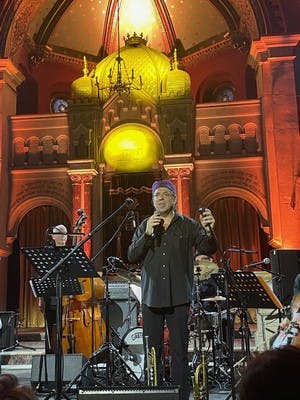
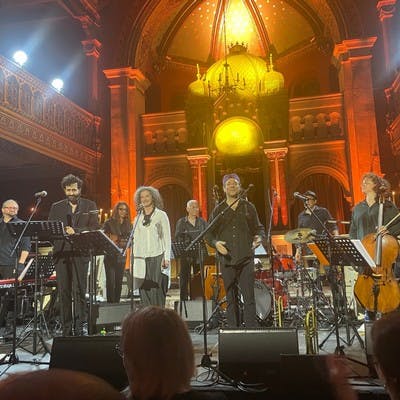
I ATTEND A FESTIVAL CONCERT in the restored Tempel Synagogue, which was ransacked during the war and used as an ammunition dump by the Nazis. The Ghetto Songs project arose from an invitation by Venetian scholar, Shaul Bassi, to trumpeter and composer Frank London, to create work that commemorated the 500th anniversary of the founding of the Venetian Jewish ghetto. The name ghetto derives from the Venetian word, geto, meaning foundry; the ghetto was established in 1516 on the site of a former copper foundry.
London, trumpet in hand, paces the synagogue stage and conducts an ensemble of virtuoso musicians. The songs range from the ghettos of the Holocaust to the black-American enclaves of Watts and Harlem; from the Venetian ghetto to the favelas of Brazil and the townships of South Africa; from the mediaeval to the contemporary, from Yiddish folk to the operatic.
There is a song that cuts to the moment: Minutn fun bitokhen (“Minutes of hope”), performed by Ukrainian-born cantor Svetlana Kundish. To sing it while her homeland is being besieged, she says, and in the city of the song’s creator, Mordechai Gebirtig, was a sacred undertaking. Written in October 1940, it is a song of defiance. ‘Yidn, be happy/don’t walk about in sadness/be patient, maintain your faith…/don’t abandon your weapon of laughter...’ As for the enemy: Mir hobn zey in d’rerd. May they be buried deep in the earth.
There is a song that cuts to the moment, Minutes of hope, performed by Ukrainian-born cantor Svetlana Kundish. To sing it while her homeland is being besieged, she says, was a sacred undertaking.
Gebirtig was born in Kazimierz in 1877. A carpenter, he plied his trade in a basement on Berek Joselewicz Street, where, it is said, he also wrote his poems and composed the melodies on a shepherd’s flute. A member of both the Polish Socialist Party and the Jewish Labour Bund, Gebirtig wrote songs of the impoverished and the unemployed, children’s songs, love songs, songs of labour and protest.
My mother was a singer of Yiddish song. She performed in pre-war Bialystok. After the war she was confined to singing as she went about her housework in the immigrant Melbourne suburb of Carlton. Gebirtig was her favourite. It is my most indelible memory of her: Hadassah singing Avremele, tu nor a kook, vi shein di zun heynt sheynt. “Avremele, just have a look, how beautiful the sun now shines…” Her singing was fuelled by rage at the murder of her loved ones. It was a statement: I am here. I have survived. I will not be silenced.
THE KRAKOW JEWISH CULTURE FESTIVAL was founded in 1988 by Janusz Makuch; he has directed the festival ever since. Makuch was raised as a Catholic during the communist era in the eastern Polish town of Pulawy. He was 14 when he first became aware that half the town’s pre-war population was Jewish, triggering a lifelong quest to expose a ghostly absence. Makuch continued his quest when he moved to Krakow. The former Jewish quarters in Kazimierz, in the 1970s, was a haunting place, he says. Dark. Abandoned. Strangely beautiful: a lost Atlantis, a forgotten Jerusalem.
Makuch is a fierce advocate of efforts to restore Jewish presence in Poland. He sidesteps controversies over the rise of right-wing forces, and simmering anti-Semitism, and prefers to focus on collaboration and creativity. The festival is central to his quest. Pre-pandemic, the annual audiences had grown to 30,000. Ninety per cent of the festival volunteers are non-Jewish. Makuch travels widely in search of musicians, scholars, writers, artists, and storytellers to present their works. I am one of the many to have been invited.
On a sweltering day, while performing in the festival tent, I hold up an object to the audience, a book of Yiddish poems. The book has been rebound many times, the yellowed pages are patched with adhesive-tape, missing pages have been replaced by glued in replicas handwritten by my father. Titled In New York, the work was written by Meier’s most loved Yiddish poet, Moshe Leyb Halperin.
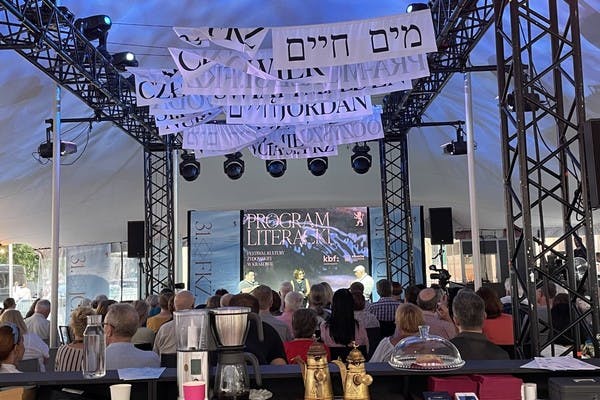
Halperin migrated to New York in 1908 from the Galician town of Zlochev. His first major work is a song cycle of an immigrant poet set in the streets and tenements of the Lower East Side, and in his home shtetl. Halperin is acutely observant. And bitter. America is no golden land. Zlochev does not evoke nostalgia. Yet there are also many poems of tender lyricism, and a consistent strain of romantic yearning.
Meier bought a Warsaw edition in 1921 and took it with him on his journey from Poland to New Zealand. Meier never returned to his homeland. In his eighties, he wrote a homage to the work, titled: An alter bukh mit lieder. An old book of poems.
I recite a fragment of my father’s poem onstage, both in Yiddish and English translation: I protected the book in the land of my birth/And I brought it with me over oceans/And long did I use it here…/And it was always so good to me/in every celebratory hour/And we aged together/Like a twin from one mother.
A century after it was published, the book has come home.
EVERY DAY THEY GATHER, women and children, by the statue of the Polish poet, Adam Mickiewicz, in the central square, Rynek Glowny. They hold aloft placards with confronting images of what is happening in their homeland. They are surrounded by beauty. “But I do not see the beauty,” says V. “I cannot afford to see it. We are not in a mind to appreciate it. I do not have a good feeling.” She takes part in the protest each day alongside her mother.
We talk by the statue as night falls. V was born and raised in a village close to the Russian border. Fifteen years ago, she left Ukraine and migrated to Australia in her mid-twenties. She returns to the village regularly. On her last return she was marooned during Covid times; the Australian borders were closed. By February, she had not seen her husband for two years.
She worked on the family farm, ran poultry, planted vegetables, tended fields of grain, and gathered mushrooms and berries. “I was stuck, but I was enjoying village life, and waiting for things to become normal. The village is beautiful, surrounded by lakes and forests. People were feeling sorry for me. I said, ‘don’t feel sorry, I’m loving life here’.
“On February 21, Australia reopened its international borders. On that day I went to Kyiv to arrange my visa. I returned to the village the same day. Mum stayed on to look after two disabled friends. On February 23 the Ukrainian government declared a state of emergency. Friends in Australia were texting and urging me to get out. They warned there would be conflict. I can assure you nothing will happen, I told them. Russian and Ukrainian lives are intertwined. How can the left hand attack the right hand? People had predicted war, but so far nothing had happened.
V shakes her head in disbelief. The night has set in. There is a chill in the air. She is seated on a stone bench beside her mother. 'I should have taken it more seriously before it happened.'
“When I go to bed, I usually put the phone on silent. I woke up at 6am. I checked the phone; there were many calls and missed messages. My husband called. He was terrified. Are you okay? Yeah fine, I said. Do you know Russia is bombing Ukraine? I did not believe him. I called my cousin in the village. Yes, the invasion has started, she told me.
"It was winter, still dark. I was still in my pyjamas. I couldn’t comprehend it. I was in denial. I called my brother and he confirmed it. I switched on the TV and social media. Oh my god. Oh my god. I was in a panic. My brother said: go to the shop, get food, supplies, canned meat. He was relaxed. Where we are living there was nothing of importance, he said, no military facilities, no factories. It was a forgotten corner of the world. Surely, they will leave us alone.
“Then I heard explosions in the distance. I called my cousin. I told him I’m scared. I am alone. Come to our place, he said. I called my mother. She was already at the Kyiv station. In the village, people were standing in the streets. They were stunned; 35 kilometres away in a town by the Moscow-Kyiv highway, they were already taking in wounded soldiers.
“I was completely in shock. Where to hide? We did not have proper bomb shelters. People were predicting they would take Kyiv in four or five days. I was scared about having an Australian passport; if I was captured, I thought it could go against me. Everything was paralysed. There were drones flying over the village. A few days later there were red fluorescent arrows on the electric poles, so we were expecting a convoy of tanks. They were bombing towns and villages all around us. We were terrified. The snow melted. We found three tanks stuck in the mud. Our village was cut off. We were running out of food.”
V shakes her head in disbelief. The night has set in. There is a chill in the air. She is seated on a stone bench beside her mother. “I should have taken it more seriously before it happened. Mum said, you should go back to Australia. You have your life ahead of you. My relatives were thinking of how to evacuate me.
“We were encircled. They were moving closer. We lost mobile connection. We did not know what was happening. Those stories my grandmother used to tell me about war, they were like legends set in a distant past, about something we thought would never happen again. I couldn’t believe we were living through it.
“For weeks we saw missiles flying over us. We did not sleep. We came out on the streets at night. There was little to eat. We were drying bread, burying meat under the ground, sharing eggs, cheese, and milk. We boiled potatoes in skin. It was the most delicious meal in my life. Then on March 14, I watched the sunset and set out for home. We were going to have chai. I saw planes flying over the house. They were so low, circling, three of them. Then a fourth and fifth.
“We had stockpiled matches, water, torches, axes and chairs underground, in a vegie storage room. We ran there, but on the way my mum said it would not be safe. She said: let’s stop and look at the planes. I was shaking. There used to be a military factory in a nearby town in Soviet times. They bombed it and damaged many homes.
“We were trapped. We found a private van. The Russians were saying: When we come, if you resist, we will do a Mariupol for you. It was March 28. We knew they were shooting at evacuation busses. There were no guarantees. You risked getting killed as you fled. I was thinking that I would rather be killed instantly than caught and tortured. There were 20 of us in the van. We drove on backroads and cut through fields. When we got back onto the highway, we saw craters and burnt-out vehicles. It was chaos. We got to Kyiv in 12 hours. The city was encircled.
“It was too dangerous to stay. We left for Lviv early morning. We arrived at night. They put us in a school classroom. There were women, children, dogs, cats, and mattresses spread on the floor. It was 3am. We were exhausted. We fell asleep. At 4.30am, the sirens sounded. There was a woman running from classroom to classroom, yelling: Get out. Get out. They’re going to bomb the airport.
“Everyone was in shock. We thought we had escaped to safety. I said to mum, let’s go to the train. We should get out now. I just wanted to go to the border. The first bus we saw over the border was going to Krakow, so we took it. I had someone I knew there and phoned them. She had a spare room in her apartment. She met us at the bus stop. She said we could stay till the end of June. We are still living there. They are very kind. They are not charging us, but I don’t know what we should do. My mother says I should go to Australia and that she will return to the village. I tell her, I cannot leave you.”
It is approaching midnight. The square is almost deserted. V has been telling her story for hours. She puts an arm around her mother and huddles against her.
THE YIVO STUDY TOUR GROUP assembles on July 1. We are bussed to the Ghetto Hero’s Square, formerly known as Plac Zgody. The square is scattered with larger-than-life iron chairs, installed on the site of the Umschlagplatz where the ghetto inmates were assembled before being marched to the station. The chairs are arranged in a grid and fixed to the ground on metal platforms.
The memorial was designed by architects Piotr Lewicki and Kazimierz Latak. Piotr stands on the pavement opposite the square and explains how they arrived at the design. They immersed themselves in the details of the ghetto’s history, read eye-witness accounts, and sifted through the archives.
The ghetto was established in March 1941, here, in the suburb of Podgorze. Jews from all over Krakow were enclosed behind purpose-built walls and barb-wire fences. The ghetto was liquidated in March 1943. The last inmates were killed on site or marched to the station to be transported to the death camps. They left behind a mass of possessions and rotting furniture. Lewicki and Latak chose the chair as representative of the abandoned belongings.
The square is still fronted by a bus station. The pre-war bus station, which was converted into the ghetto police station, remains intact. The date, 1941-43, is engraved on the pediment. Passers-by, consciously or otherwise, interact with the chairs, as they do with other objects: wastepaper bins, traffic signs, bicycle parks, and tram-stop awnings. To walk the square, and the surrounding streets, is to understand that there was no escape route. Wherever the inmates may have run, whatever part of the wall they may have scaled, they were easy targets.
The square is scattered with larger-than-life iron chairs, installed on the site where the ghetto inmates were assembled before being marched to the station.
My thoughts return to Mordechai Gebirtig. The Nazis occupied Krakow on September 6, 1939. Gebirtig and his wife and daughters were driven out of their home in October 1940. In his poem, Farewell Krakow, Gebirtig writes: The hitched wagon awaits outside my house/ the savage enemy hounds me out/as one would hound out a dog … For a year the family lived in a hut in the village of Lagievniki. In early 1942, they were incarcerated in the Krakow ghetto. Gebirtig continued to write. He clung to hope for as long as possible.
As the noose tightened, his songs were increasingly driven by rage and disillusion. His final song, written weeks before his death, is ironically titled, It’s good. It is a cry for a day of reckoning. “It’s good,” Gebirtig concludes, addressing his tormentors: “Your end will come soon.”
Gebirtig was marched from the ghetto square towards the station on June 4, 1942. There is a story told that he broke from the ranks and began to dance and sing at the top of his voice. Another tale has him shot while sitting on a stone in the street, writing a poem. Others contend he was shot at the train station, as his fellow inmates were boarding the cattle cars. Whatever the exact circumstances of his shooting, those who did make it to the trains were transported to the Belzec death camp.
I RECEIVE A MESSAGE from Dale Umetsu: “I did get to the train station in time, but the train was delayed a bit. I had a great trip to Jaroslav and was picked up by my colleagues and taken to a small town further east. We’ve been going to Ukraine every day to visit several refugee centres, where we see 20-30 patients each time. The patients have many sundry problems, most of which we can treat with medications that we carry with us.
“We see mostly adults, but some kids, with problems such as heart disease, post chemotherapy patients, arthritis, thyroid disease, respiratory disease, eczema, headaches, heat stroke and so on …I work with two family practice physicians, so I’m learning a lot from them. We travel to several places in Ukraine and so far, everything seems safe. We spend about 30 minutes crossing the border, always taking the priority lines …”
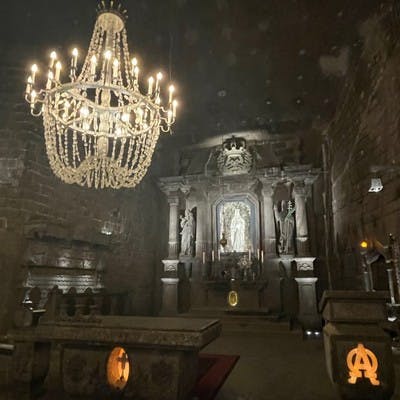
THE STUDY TOUR IS ON the road, on excursions from Krakow, first to the Wieliczka Salt mines, a labyrinth of saline corridors, chambers and chapels, and an underground church lit by rock-salt chandeliers, presided over by the mine’s patron saint, St Kinga. The following day: The ascent from the Vistula valley to the Tatra mountains, home to the highland people, the Gorale, master builders of multi-storied timber homes with carved facades and steep roofs of wood shingles.
I first travelled here from Krakow in the autumn of 1986. It was a journey of release back then. I continued by foot from the resort town of Zakopane, beyond the final bus stop, climbing towards the higher reaches, retracing the escape routes that Jews had taken to Slovakia guided by the Gorale people. I did not want to stop. I wanted to get as far as possible from that receding dot back in the Vistula valley, called Auschwitz, where my maternal grandparents and their extended family were murdered.
With each step I felt lighter, but I did not know then, as we are informed now, by the tour’s resident historian, Professor Samuel Kassow, that among the Gorale smugglers there were those who betrayed their Jewish charges to the Nazis for an additional bonus.
But there are days like this: a glorious Sunday, a sense of ease and well-being, summer crowds thronging the streets of Zakopane; and the winding road back to Krakow, with glimpses of sheep grazing on mountain pastures, and of storks peering from giant nests balanced on rooftops and electricity poles; and the idle walk from the bus back to the central square, where a black American woman sings New Orleans jazz in an outdoor bandstand while the setting sun strikes gold on accompanying trombones and trumpets.
But that night, V and her mother are back by the statue of the poet. She is agitated, something has changed. There are rumours of expiring limits on the number of Ukrainian refugees that Australia will guarantee residency; the borders may again be closing. V is weighing her options.
“It is a battle between heart and mind,” she says. “My brain says quick, book a flight to Australia before it’s too late. I don’t have enough funds, but there are friends and colleagues who have offered to help. They are urging me to get out. But my heart says: I must stay here with my mother until it’s safe for her to return to the village. I can’t abandon her. I can’t abandon my people.”
This is how it has been since the invasion: surely it will soon be over, the people believed. Surely by April, by June. Or certainly by autumn. But now it is sinking in, this war may go on for a long time. But what to do? Return to Ukraine? Cross the oceans, and venture so far from the homeland?
“In Poland,” says V, “at least we are in a similar landscape; every now and then, an exclamation of joy at the sight of a tree we have back in the village.” But the joy is short-lived. The panic returns. What can we do? What should we do? It is time for a decision.
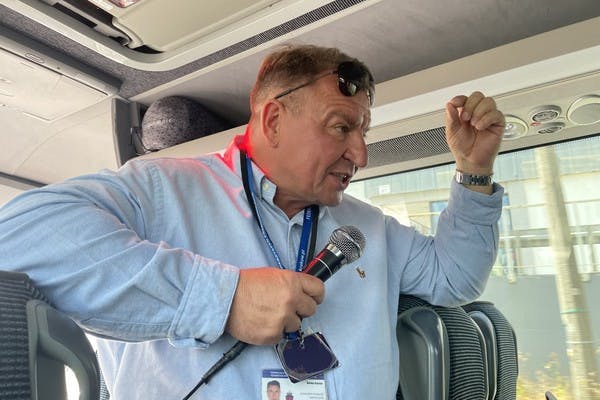
THE STUDY TOUR HEADS WEST from Krakow to Wroclaw, by way of Czestochowa. Dariusz Kuzniar, tour director, streetwise storyteller, sardonic observer of political corruption and abuses of power, makes his way along the aisle dispensing good cheer and vodka. Each day he offers alternative brands and sings their praises: “This one is named after Mickiewicz; it will inspire poetry. Or perhaps you prefer Bocian, which means stork; it will bring you babies. And today, Soplica, it has a lovely fruity flavour. Just one shot and you will live longer. It’s good for you.”
The landscape flows by - fields of sunflowers, forests of oak and beech, and of birch and conifers. A tractor kicks dust on a country road; a chestnut tree towers over a village pathway. I have not travelled in Poland for 16 years and I am startled anew by a sense of recognition. I am returned to an autumn Sunday, 1986, when I first entered the country by train over the eastern borderlands. The terrain was familiar, the townlets as I had imagined them from the tales of my elders, and as depicted in the songs my mother sang of blessed summer evenings descending on silent forests.
Each one of us in this intimate group of 12 has affinities with the passing landscape, each one our yearning for familiarity, our oscillations between a sense of recognition and absence.
Each one of us in this intimate group of 12 has affinities with the passing landscape, each one our yearning for familiarity, our oscillations between a sense of recognition and absence. Birds of prey circle the skies above the rotating blades of windfarm turbines. We are a band of Don Quixotes tilting at history’s bitter ironies.
And wherever we go, whatever stretch of highway, there is the good professor, Samuel Kassow. His resonant voice draws us out of our reveries. His observations are punctuated with names, dates, and data. They are the hard-won fruits of a lifetime of research in a multiplicity of languages: Yiddish, German, Russian, Polish, and Hebrew. But beyond this, there is Kassow’s skill in weaving the facts into a compelling narrative.
His talks seem to chart their own course, in sync with the rhythm of the bus charting its course westwards. He is both scholar and storyteller. He recounts tales of betrayal and courage, the depths of human barbarity, and the heights of human endurance. He weighs up contending interpretations of the evidence. He crafts his talks with patience. “Schweya, Schweya, slowly, slowly. Haste is from the devil,” the desert people say. In Jewish mythology Samuel Kassow would be cast as the Messenger.
Yet there is something else. Patient though Kassow’s talks may be, there is an underlying current of urgency. He embodies the history. This is apparent one afternoon when, yet again, his voice rises from the silence in harmony with the tour-bus rhythm. He is recounting his own family history. The tale centres on his mother, Celia: resistance fighter, partisan, fierce keeper of family secrets. It was a time “of choiceless choices”, Kassow cautions, leaving in their wake unintended compromises, desperate love-affairs, and acts of audacious courage. It is a harrowing and at times wondrous tale that finally returns him to a remote village in Byelorussia in search of revelations.
Perhaps this family chronicle is what has driven Kassow’s lifetime immersion in the brutal histories of Eastern Europe, and what binds him to the landscape we are now traversing. It is his tale to recount, and one that we urge him to write as a full-length memoir. It would be his crowning work, and we all know by now that the good professor possesses both the scholarship and storyteller’s instinct to do it justice.
CZESTOCHOWA, MID-MORNING, home to the Black Madonna. The icon presides over the hilltop Jasna Gora Monastery, where the chapel walls are crowded with the discarded crutches of pilgrims who claim the Madonna had healed them. But our few hours here are not focused on miracles. Instead, we are ushered down a flight of stairs from the pavement fronting the former assembly grounds of the Czestochowa ghetto, to a bunker where 27 inmates of the one family hid, while above them, murder and mayhem, the roundups of inmates destined for the death camps.
Again, we are in a living memorial. Tactile. Suffocating. It is hard to fathom how the inmates could endure the tiny grotto-like warrens, the claustrophobia, the dread of being caught, and the imperative to remain silent.
It is a release to be back on the open highway. The sun is out, and another city is approaching. Wroclaw is a university city, with its fair share of youth. We will see them in the following days, gathering at night in the Market Square, and seated on the banks of the Oder River on a balmy summer evening as we cruise the waterways of the "Venice of Poland": a city adorned with 12 islands and 130 bridges, as the people of Wroclaw can tell you with precision.
Marcin Wodziński, director of the Department of Jewish Studies at the University of Wroclaw, leads us through the streets of the inner city. Like Janusz Makuch, as a young Pole, Marcin was drawn by traces of an absence: “You need to understand the situation in the 1970s and 1980s in Poland,” he says.
“… After 1968 [and the government-led antisemitic purges], topics related to Jewish culture were unfavourably treated by the communist regime … At the same time, if you live in Poland, if you walk the street, when you travel, wherever you go, you see a building that is very distinct, very different to all the architecture around, and you realise, this is something different.
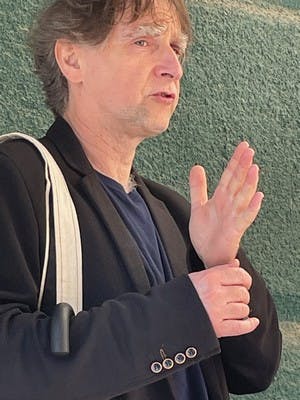
“Then you have these empty lots of space somewhere in the middle of town, with strange stones, covered with letters that you can’t understand, you can’t read, with beautiful symbolical images, and it’s there, and it’s obviously something that talks to anybody. You want to know what it is. So it started for many people … and it was also interesting to me, it was also attractive in the way that this was close and exotic at the same time, but it’s also a kind of moral obligation … the last remnants of a murdered culture.”
After years of scholarship, Marcin possesses within him the maps of Jewish Wroclaw. It is a glorious morning, and he is guiding us through an alternative universe. This is where, he points out, the renowned Yiddish actress Ida Kaminska performed, and there, under the archway, is the White Stork Synagogue, the only one to have survived the Holocaust. And here, in the synagogue forecourt, is where the Jews of Wroclaw were assembled for deportation. And there, across the road, is where a certain number of Jewish families were allowed to reside in the 13th century, to represent their community’s financial interests.
My maternal grandfather was a Slonimer Hassid. Several times a year he would take the train from Bialystok to Slonim to spend time with the Slonimer Rebbe. Your grandfather had a beautiful voice, my mother said.
Among Marcin’s most celebrated works is his Historical Atlas of Hasidism. One of the many locations where Hasidic courts flourished is Slonim. My maternal grandfather, Aron Yankev Probutsky, was a Slonimer Hassid. Several times a year he would take the train, with his fellow Hassidim, from Bialystok to Slonim to spend time with the Slonimer Rebbe. Your grandfather had a beautiful voice, my mother said. “Reb Aron, geb undz a nigun”, give us a melody, his Hasidic brothers implored whenever he stepped into the Slonimer prayer house on Sabbath nights back in Bialystok.
A shot of brandy and the melodies would flow, and shoulder to shoulder they would dance in an ever-faster moving circle, beyond the drudgery of their daily lives, beyond the imperative to eke out a living, beyond their earthly struggles, to the higher heavens; and invariably, whenever she told me the story, Hadassah’s gaze would turn dark, and her eyes would be fixed elsewhere, on an absence called Bialystok.
And it is Bialystok that I invoke that evening in the White Stork Synagogue, where I trade stories with singer-songwriter and cultural activist Bente Kahan. Born and raised in Norway, since marrying exiled Solidarnosc activist, Alexander Gleichgewicht, Bente has divided her time between Oslo, and her husband’s home city of Wroclaw, where, in 2006, she established a foundation to help restore the White Stork Synagogue as both a place of worship and a centre of Jewish culture and education.
Our “stage” is the restored mikvah, the ritual bathhouse; the white-tiled wall is our backdrop, and the iron rails are all that divide us from the glistening green waters of the mikvah. One of the stories I tell is of a fragile exercise book. I thought I knew all my father’s Yiddish poems, and I had documented them after he died in 1992, both those he wrote as a young poet in Bialystok, and the final poems he wrote in his retirement after a 40-year detour working in factories and on market stalls.
I discovered the exercise book just three years ago, I tell the audience, as I was sifting through a cardboard box that contained some of my father’s eccentric jottings. It was inconspicuous, so easily lost, titled: Poemes fun meine yunge yoren, “Poems of the years of my youth”. The collection begins with my father’s first published poem: A Shepherd. I recite the opening six lines:
Oy vi gut a pastukh iz tzu zein/vi gut iz dukh der gantzer tseit/ven zun makht dukh ir veg/fun mizrakh biz tsu meyrev breg/un gist in moyl fun velt arayn/azoi fill emers varmen shine.
Oh, how good it is to be a shepherd/how good it is to spend that time/when the sun makes her way/from the eastern to the western side/and spills into the mouth of the world/so many buckets full of warm sunshine.
In return, Bente performs Gebirtig’s much loved song Kinder yorn, “Childhood years”; and she recounts a tale of her father, and the basement of his Oslo home, containing his collection of Yiddish books, among them a hand-written notebook with his repertoire of songs and their musical notations. Bente holds the notebook up to the audience and performs one of the songs: Mamme kum tsurik. “Mother come back”. Our tales turn to our bobbes, our tough grandmothers, and our mothers, and their quests for modernity.
We are a generation who never knew our grandparents, says Bente. Absence and a craving for restoration, this is the tension that fuels our performance. And at this moment, onstage, in the mikvah of the White Stork Synagogue, the pendulum arcs towards restoration.
THE STUDY TOUR IS MOVING WEST; each kilometre takes us further from the fraught eastern borderlands. Only as we walk the streets of Dresden do I realise there have been no border checks, just an imperceptible flow from one country to another, in sharp contrast to the heavily policed-border I encountered in 1986 en route to walled-off West Berlin by train from Warsaw.
We are joined by Berlin-based tour guide, Ronan Altman-Kadar. If you would have stopped in Dresden, before the reunification, he says, you would have seen many historic buildings left in ruins by the East German authorities as a symbol of the Anglo-American bombings. After the reunification the money poured in, and the city was fully restored to its former glory.
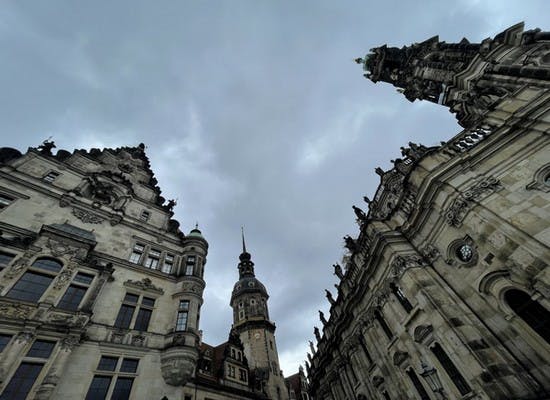
But I am disoriented, dwarfed by the grandiose castles, palaces, and churches. Something is not right. I can appreciate the artistry, and the feverish imagination that informs the baroque architecture: its gilded angels and clockfaces, the ornate arches and doorways, swirling pillars and copulas. But on this bleak, showery morning, it strikes me as an architecture of imperial conquest. It unnerves me.
A song my mother often sang comes to mind, The Naked Young Man from the Swamps, written by the Soviet-Yiddish poet, Itzik Feffer: Look at that cottage that stands not so far/who was it that built it, who was it?/Who was it that built it of brick and of clay?/The naked young man from the swamps. On August 12, 1952, after decades of singing the praises of Stalin, Feffer was executed, along with 30 fellow Soviet-Yiddish writers and intellectuals. There is no escaping the brutality of tyrants.
MID-AFTERNOON WE ARE on the outskirts of Berlin, moving past the Tempelhof fields, the site of the former airport, and Samuel Kassow and Dariusz Kuzniar are trading tales of its chequered history. During the 11-month siege of Berlin, the airport became the conduit for supplies flown in from the west. There were 700,000 missions; a plane landed every 62 seconds. Several years ago, two hangers were used to house Syrian refugees. The grounds of the airport are now a public park. Berliners are out strolling, flying kites, biking.
Late afternoon we disembark at the Topography of Terror, a museum built on the bombed site of the former Nazi regime headquarters. Here stood the head offices of the SS, the Einsatzgruppen, the SD, the Sicherheitspolizei, and the Gestapo. We are left to wander a rectangular glass edifice, housing an exhibition that traces the rise of the Nazi party — the evolution of an apparatus of terror, its structures, and key figures.
The black and white photos on display are distressing — images of public humiliations, the cold indifference of passers-by, the public shaming of couples who dared love beyond cultural borders, and of SS men and women carousing and picnicking. They are blunt and revelatory, their impact heightened in the spacious well-lit display hall.
It is poetry that I turn to, in the face of the horror, and to Bente Kahan, the previous evening, onstage in the mikvah of the White Stork Synagogue. She is singing In the Middle of Life, a work by the Polish poet and playwright, Tadeusz Różewicz. Born in 1921, in the town of Radomsko, during the Nazi occupation Różewicz fought with the underground Polish home army. What he experienced was to haunt him for the rest of his life.
In his writing, Różewicz battles to affirm the sanctity of human life, against the antithetical human impulse for evil. His poem, In the Middle of Life embodies his struggle. After the end of the world, after his death, a man finds himself in the middle of life. He recreates “people, animals, landscapes”, the objects of everyday life, and he names them, and in the naming, he attempts to rebuild his life:
…This is a window I kept saying this is a window/beyond the window there is a garden in the garden I see an apple tree the apple tree blossoms/the blossoms fall off fruit forms/ripens/my father picks an apple the man picking the apple is my father/I was sitting on the front steps of the house that woman/pulling a goat on a rope/is more needed/is worth more/than the seven wonders of the world anyone who thinks or feels/she isn't needed/is guilty of genocide ...
BERLIN. THE FIRST NIGHT. It is unseasonably cold. I walk the near-deserted streets. My umbrella bends to the wind. A makeshift shrine to the Ukrainian resistance lies on a median strip. The flowers are crumbling, the soaked placards are held down by stones, the circle of red candles has been extinguished. I make my way to the Friedrichstrasse Station, and step into a felafel store run by Turkish immigrants. The manager’s eyes blaze with purpose. He is firmly in charge. He directs the show and engages in banter. He reminds me of the vision of Kilian: he possesses the fierce energy of the exiled. I return to Unter den Linden. A saxophonist plays by the Brandenburg Gate, as he does every night. Tonight, he has it all to himself.
BERLIN IS NOW a city that remembers. There are ten-centimetre square brass plates imbedded in the pavements; Stolpersteine, “stumbling stones”, they are called. Produced by hand, each records the victim’s date of birth and place of death, and is located at the last home, or workplace, in which the person freely lived before being rounded up and deported by the Nazis.
The idea was conceived by German artist Gunter Demnig who laid the first plates in the city of Cologne in 1992. The idea spread. As of 2019, over 75,000 stones had been laid in cites throughout Europe. The names are of Jews, and other victims of the Nazi terror: Sinti and Romani people, homosexuals, the disabled, social democrats, trade unionists, and other resistors who were driven to suicide or murdered.
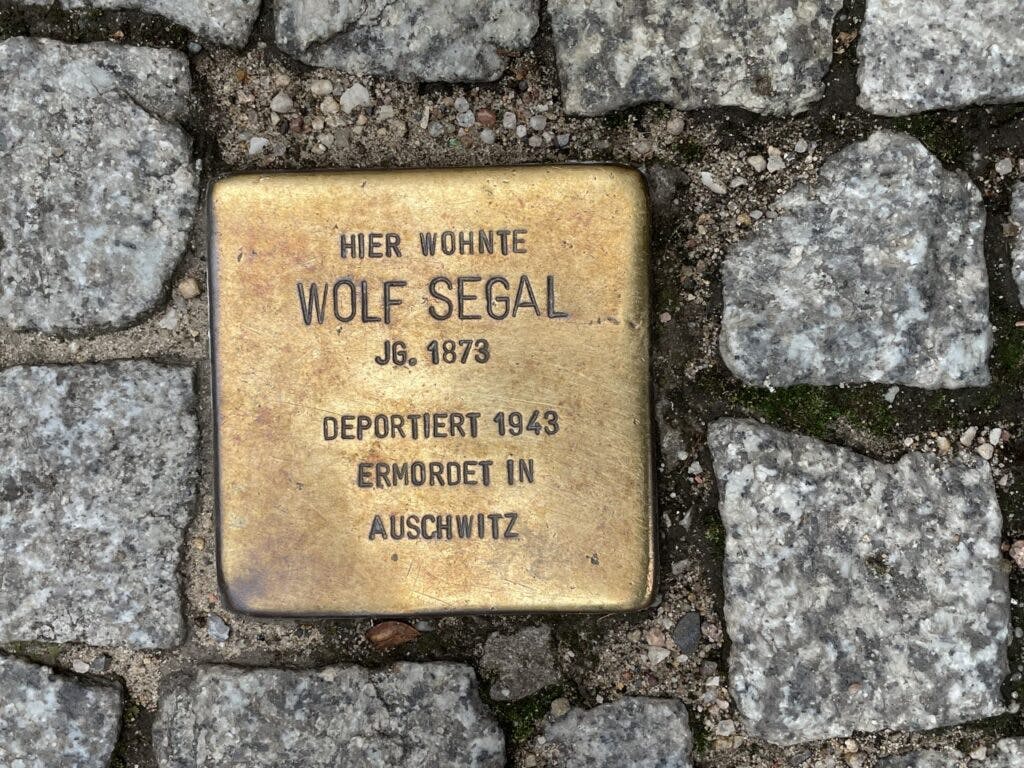
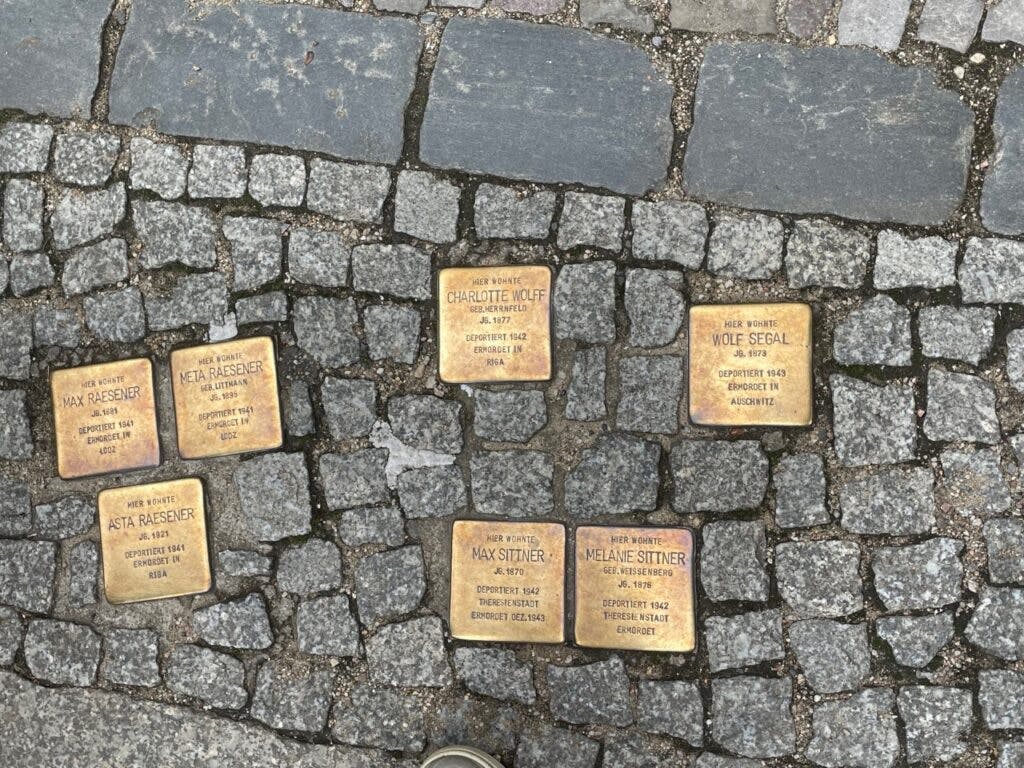
Because the plates are made of brass, each step that passes over the plates, whether conscious or unwitting, adds to the glow, the polish.
To read the inscriptions one must bow down to the names. As our Berlin guide, Ronan Altman-Kadar, points out, the most beautiful thing is this: because the plates are made of brass, each step that passes over the plates, whether conscious or unwitting, adds to the glow, the polish.
RONAN DIRECTS US under an archway into a courtyard on Rosenthaler Strasse, in the Mitte district, to Otto Weidt’s Workshop for the Blind. During the war the factory manufactured brooms and brushes. Now a museum, the rooms and floorboards are well-preserved, the machines and workbenches in place. The museum recounts a tale I hunger for — the tale of a good man.
Otto Weidt was born in 1883 into a working-class family. He established his workshop in 1936. He married Else Nast the same year; she shared his humanism, and his abhorrence of the Nazi regime. Many of Weidt’s employees were Jews and he protected them by whatever means possible. He kept the factory going by entering contracts with the Wehrmacht. He printed forged identity cards. He bribed officials. When deportation loomed, he hid workers in the apartments of trusted friends, and in a concealed backroom in the workshop building.
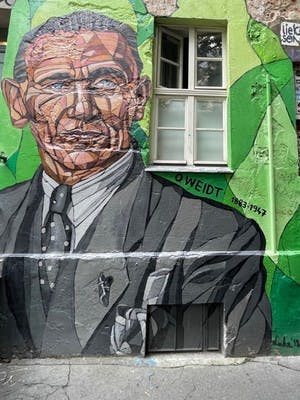
When a group of his workers were betrayed in 1943, and sent to Theresienstadt ghetto, Weidt sent them food parcels. When his employee, Alice Licht, was deported to Auschwitz, Weidt travelled there under the pretext of selling his brushes to camp authorities. He traced her movements to Grosse Rosen Concentration Camp and devised a way to leave her medicines, clothes, and money. Alice escaped the camp and survived the final months of the war in Weidt’s Berlin apartment.
After the war Weidt established a home for Jewish orphans and aged survivors. He died in December 1947. The beauty of his endeavours is reflected in the photos of the people he sheltered. They grace the walls. There is a photo of Weidt and his workers; there are about thirty in all. Weidt sits on the floor in the front row as one among equals. In this moment they are an extended family. Protected. United in their common humanity.
THE BERLIN JEWISH MUSEUM was designed by architect Daniel Libeskind. We are of the same generation, children of the Jewish Labour Bund. Libeskind was born in Lodz in 1946. Post-war, a group of Bund survivors regrouped in Lodz. For a brief period, they tried to rebuild Jewish life in Poland. After the Kielce pogrom in 1946, and the occupation by the Soviets two years later, the dream was extinguished. Many Bund members left, some taking the escape route via the Tatra mountains. Libeskind studied architecture in the US and England. He conceived the museum building itself as a means of conveying a sense of displacement and absence.
I descend to the lower levels. The floors rise and fall; the corridors zigzag, the towering concrete walls enclose voids, bare spaces. I wander the museum for hours. Again, I am in search of just one story. It is an object that leads me to it, a flamenco dress. Dated, Hamburg, circa 1980s. The waist flares into a flamboyant skirt; white polka dot frills alternate with mauve and white stripes edged by pink ruffles. The dress belonged to Sylvan Rubinstein.
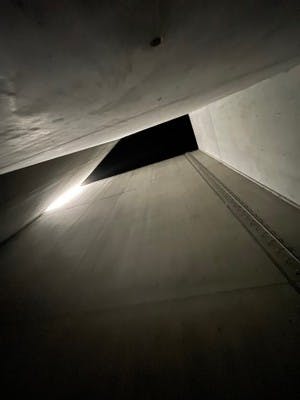
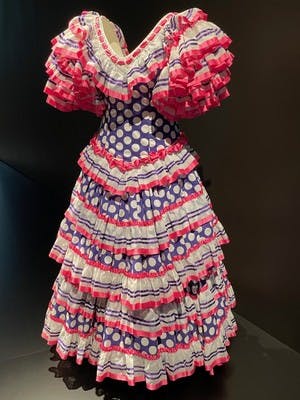
Sylvan and Maria Rubinstein were twins, born in Russia in 1917. When their aristocratic father was executed by the Bolsheviks, their mother fled with them to Poland and settled in the town of Brody. To earn a living the twins danced in marketplaces. They honed their skills as flamenco dancers and performed in music halls throughout Europe, and in New York and Melbourne, billed as Imperio and Dolores.
The twins were performing in the Adria theatre in Warsaw when the Germans invaded. They were incarcerated in the Warsaw Ghetto, escaped, and went underground. They vowed to stick together but for a moment they separated, and Maria vanished.
After the war, Sylvan settled in Hamburg. When he died in 2011, he left behind numerous dresses he had designed. "His sister’s fate remains unknown," concludes the tale on the museum panels.
After the war, Sylvan settled in Hamburg. He performed in the St Pauli district, and throughout West Germany as Delores. When he died in 2011, at the age of almost 97, he left behind numerous dresses he had designed. “His sister’s fate remains unknown,” concludes the tale as recorded on the museum panels.
There is a photo of Sylvan performing as Dolores in a flamenco dress in the 1950s. The silky black bodice hugs a slim upper body. Sylvan’s high kick fans out the dress in an inverted parabola. And a photo of Sylvan as a matador: dressed in a black fedora, a white blouse, high-heeled boots, an embroidered vest, and black trousers. His fingers clasp castanets, his shoulders are erect, his bearing regal. And a quote from Sylvan emblazoned above the dress: “Flamenco was in my sister’s and my nature. It is Sephardic. It is Moorish. When I danced, my dear sister was always with me.”
That night I search online for more details. Indeed, a biography has been written, and a documentary filmed of Sylvan. He returned to the stage in his nineties dressed as Delores to perform for the film, and entertained audiences with his tales of the duo’s exploits. Maria vanished, he says, when she boarded a train headed to Brody in search of her mother.
After she disappeared, Sylvan joined the resistance and carried out attacks disguised as a woman. His sister and mother perished in Treblinka. Says Sylvan: "Becoming Dolores was my way of coping with my twin sister’s death ... only a twin can understand how horrific that was. It was like being torn in half. Not a day goes by that I don’t think of her."
I HAVE SEVERAL HOURS to wander the streets of Berlin. Where to go? I phone singer-songwriter Daniel Kahn, who lived for over a decade in Berlin. Now based in Hamburg, Kahn is a co-founder of the Mordechai Gebirtig Project, launched in 2017 by a collective of musicians to mark the 75th anniversary of his death. Kahn’s most recent album, Word Beggar, begins with a song by Gebirtig, Der zinger fun noyt. "The singer of need." The impoverished singer must perform for the rich to survive; the poet is incensed by the perverse disparities between the poor and the wealthy.
We canvas the possibilities. Given our mutual obsessions we arrive at the obvious: Bertolt-Brecht-Platz. I make my way to the Friedrichstrasse Station, cross the bridge over the Spree River, and turn left. The embankment, in the former ship-builders district, is lined by a strip of restaurants and cafes, and just beyond them: my destination.
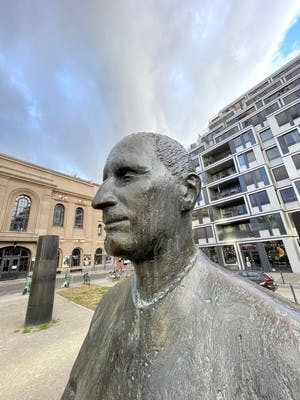
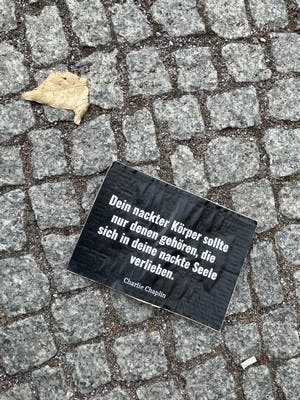
Brecht fled Germany in 1933. After returning from exile to his homeland, he founded the Berliner Ensemble with his wife, actress Helene Wagner. Since 1954 the ensemble has been based in the riverfront theatre. There is a statue of Brecht in the square. He is seated on a bench, cap in hand, a wry smile on his face. Etched in stone on the circular dais is his 1935 poem: Questions from a Worker who Reads. Lying on the pavement, outside the theatre entrance, is a piece of black cardboard, and printed in white, the words of Charlie Chaplin: "Your naked body should only belong to those who fall in love with your naked soul." Beside it lies a fallen leaf.
In this moment, beneath a mild sun on its descent over Berlin, and in the same clear skies, a half-moon rising, I feel a great love for Brecht, and for artists whose work is compelled by an urge to shed light on injustice. In this moment, I can believe all is possible. Despite it all. Because of it all.
I RECEIVE AN UPDATE from Dale Umetsu, accompanied by two photos. The school basketball court floor is crowded with mattresses, covered in bedding. Clothes dry on indoor washing lines. The windows are partly covered by makeshift curtains. Possessions are piled against the walls in suitcases, backpacks, overnight bags, and cardboard boxes. A pregnant woman lies on a mattress; an elderly woman bends over to make her bed. A girl in a green tracksuit walks an aisle with a heavy rucksack.
“Just sending you some pictures of the sites that we visit. These are in schools in Ukraine housing refugees. Lots of chronic problems like heart disease, high blood pressure, likely worse from stress, joint problems, infections, and so on. We also work at the border, seeing patients who have been on long bus trips and have similar problems along with nausea, vomiting and diarrhea. Travel through the border though seems to be declining right now.”
THE FINAL LEG of the tour, the tempo quickens. The days are outrunning me, the stories outpacing me. The welter of information overwhelms me. But there is a lake where I find respite. It is a breezeless day, the final afternoon of a whirlwind journey. Yachts are becalmed mid-lake, weeping willows and clusters of reeds rim the foreshore. White-billed black coots cruise over wisps of reflected cloud and the glistening leaves of the waterlily. The stillness releases images of what we have seen, and heard, over these past few days:
POTSDAM ON A RAINY AFTERNOON, the Cecilienhof Palace, built in the style of an English manor house; the carpeted conference room, and the round table, where Stalin, Truman, and Churchill, and his successor Atlee, sat over a two-week period in the summer of 1945, and carved up Europe. Where they moved populations about, and defined the new post-war borders, setting the stage for future conflict and division. In a frightening moment Truman informs Stalin that the US has tested a bomb that can wipe out an entire city in one go. Stalin appears unphased; his intelligence already knew. Days after the conference ends the bombs are released over Hiroshima and Nagasaki.
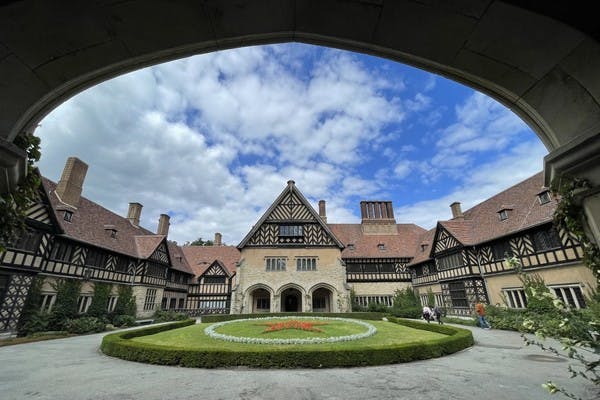
THE GRUNEWALD RAILWAY station, in a wealthy suburb of Berlin, the assembly point for the deportation of 55,000 Berliner Jews. The roundups took place in the dead of night over a period of years, for "relocation to the East", a euphemism for murder and slave labour. The victims were driven to the station in trucks in groups of up to one thousand. There is a memorial on an unused platform, installed in 1998. The dates and destinations of each transport are recorded underfoot, on a network of iron plaques. The first is dated 18/10/1941. The final transport: 27/3/1945. By then, the war was all but ended, but the Nazi mania to exterminate the “virus”, was not yet over.
ANDRAS VARGA STANDS in the nave of the Rykestrasse Synagogue, in Berlin’s Pankow borough. He wears a worn suit, a straw hat, a white shirt, and a striped red tie. He looks at the floor as he talks and clenches his fists to accentuate his barely audible pronouncements. His voice is frail, and we strain to hear him.
“I was born in the Budapest ghetto on 17th of July 1944,” he says. “I lost 54 relatives. As a survivor of the Shoah, I must go to schools and give talks. It is my mitzvah, my deed, so it will never be repeated. The synagogue survived the fire on Kristallnacht; the head of the Berlin police protected the property. The synagogue opened in 1904; it is the largest in Germany.” Andras can recite the names of a succession of rabbis, cantors and renowned members of the congregation, dating back to the synagogue’s inauguration.
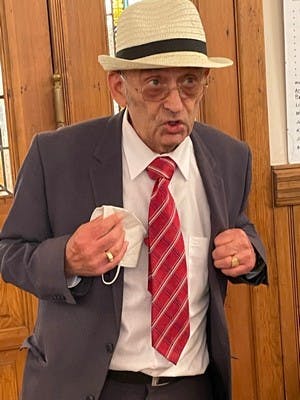
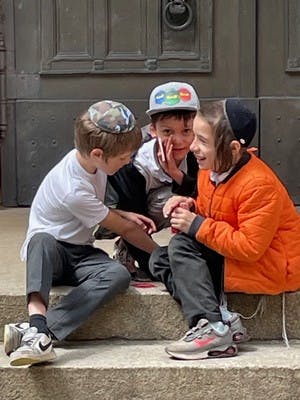
Children from an Orthodox Jewish school are at play in the walled courtyard. A group of boys play table tennis. Three boys sit on the steps engaged in conversation. Girls run with yellow and black balloons; they hold them aloft as if about to take flight. Andras steps out of the foyer and surveys the children like a proud father. He is the protector of the synagogue, and the synagogue protects him. He wears it like an outer garment.
"I lost 54 relatives. As a survivor of the Shoah, I must go to schools and give talks. It is my mitzvah, my deed, so it will never be repeated."
Andras Varga
THIS MORNING, JUST AN HOUR AGO: the “House of the Wannsee Conference”. An opulent Italianate mansion. Lake vistas are framed by arched windows and portholes. Manicured lawns slope down to the waterfront. Tree-lined avenues cast shadows over elegant garden benches. Here is where senior representatives of Nazi state agencies gathered on January 20, 1942, over breakfast, at the behest of Reinhard Heydrich, director of the Reich Security Head Office, to prepare, in his words, for the “total solution of the Jewish question in Europe”.
The killings had already begun, but more efficient methods of extermination were needed than mass shootings by paramilitary death squads. The villa is now a place of remembrance. The exhibits document the proceedings of the conference, and their terrifying consequences. Towards the end of the ninety-minute meeting, cognac was served. Tongues were loosened. Euphemisms for genocide were replaced by explicit talk of extermination.

Again, a sense of unreality: the details of slaughter conceived in such beautiful surroundings. We leave by the driveway and walk through a tree-shaded neighbourhood. The streets are lined with summer retreats and mansions, tradesmen are at work on building sites.
This is a tale of two lakeside villas, half a kilometre apart, the first where genocide was planned, and the second, the pre-war summer retreat of German-Jewish impressionist artist Max Liebermann and his family. The grounds house the artist’s studio and a homely villa, its walls softened by coats of ivy and windows framed by green shutters. Liebermann built the residence in 1909 and spent his summers here until his death in 1935. He was spared the final solution and bequeathed all who come here the beauty of his work, and the radiant gardens he co-designed and nurtured.
I walk the gravel path from the villa flanked by beds of roses, manicured hedges, and a meadow of orchards, to the waterfront. Later today, we will return to central Berlin, and Ronan will guide us through the former cabaret district. He will hold up his folder of photos depicted what once stood here. He will recreate the romance.
This is where Marlene Dietrich went to school. And there lived the Russian émigré writers, Ilya Ehrenberg, Nabokov, and Gorky, and the Yiddish poets Kulbak and Bergelson. Here stood the Monopol Café, its tables cordoned off in three sections, for Yiddish, German and Hebrew speakers, and over there, the Romanisches Café, the meeting place of artists, writers, journalists, and directors: Bertolt Brecht, George Grosz, Billy Wilder, Eric Maria Remarque, Ernst Toller. And there, across the road, in that actual building, Josephine Baker danced with choreographed abandon: the antithesis in spirit of the horrors that were about to engulf the city.
At Alexander Platz, Ronan will pause on the pavement, and hold up a photo of Mascha Kaléko. This is the story he will dwell on at greatest length. Born in 1907, in Chrzanow, Galicia, Kaléko rose to fame in Weimar Berlin for her satirical poems on big city life. Her works were, inevitably, banned by the Nazis. Then followed a life of exile, sojourns in New York, California, and Jerusalem. Kaléko died in Zurich, en route for a final return to her beloved Berlin, the city of her longing. The title poem, in a collection of her work, published in 2010, is aptly called: No matter where I travel, I come to Nowhereland.
THIS IS THE PARADOX: in this moment, at Lieberman’s villa, standing on the shores of a lake whose name is associated with genocide, I feel at home. This is the scene I am compelled to end with: the serenity, the reflected clouds, the still waters, and the gliding coots. I last saw coots just two weeks ago, in Melbourne, in my local parklands, swimming on a series of ponds I call Zen Lake for the solace they have provided during the time of the pandemic. In this moment, this too is a Zen-lake. It allows what I have seen on this whirlwind journey to settle. This is how it can be: Absence replaced by presence, longing by a sense of belonging.
THAT NIGHT I RECEIVE a message from V. She has booked a flight for Australia. Her mother is flying with her. Coincidentally, she is scheduled to fly tomorrow, 12 July, the day that I too am to begin my flight home. Again, a paradox, and an irony: the experience of the invasion has intensified V’s love of her homeland. It has brought her closer to her past, and to her people. She cannot bear the thought of being so far distant from her family, and her beloved village. She is overcome by a profound sense of guilt at abandoning her people, a guilt that mirrors the guilt that all but destroyed my mother. Of her impending return to Australia, V writes: “Having such a heavy heart. It’s so far from home. Going to nowhere …”
Main photo: A woman wraps herself in a blanket to keep warm as she waits in a crowd of refugees after fleeing from the Ukraine and arriving in Poland, in March (AP/Markus Schreiber)
All other photos by Arnold Zable
Arnold Zable’s attendance on the YIVO study tour was made possible by the generosity of a member of the YIVO board of directors. For more information on YIVO study tours for 2023, contact info@yivo.org
The quote from Marcin Wodziński is from a 2013 interview by Christa Whitney for the Yiddish Book Centre. V is an assumed name for reasons of privacy. The fragment of ‘In the Middle of Life’, by Tadeusz Rozewicz, was translated by Joanna Trzeciak.
